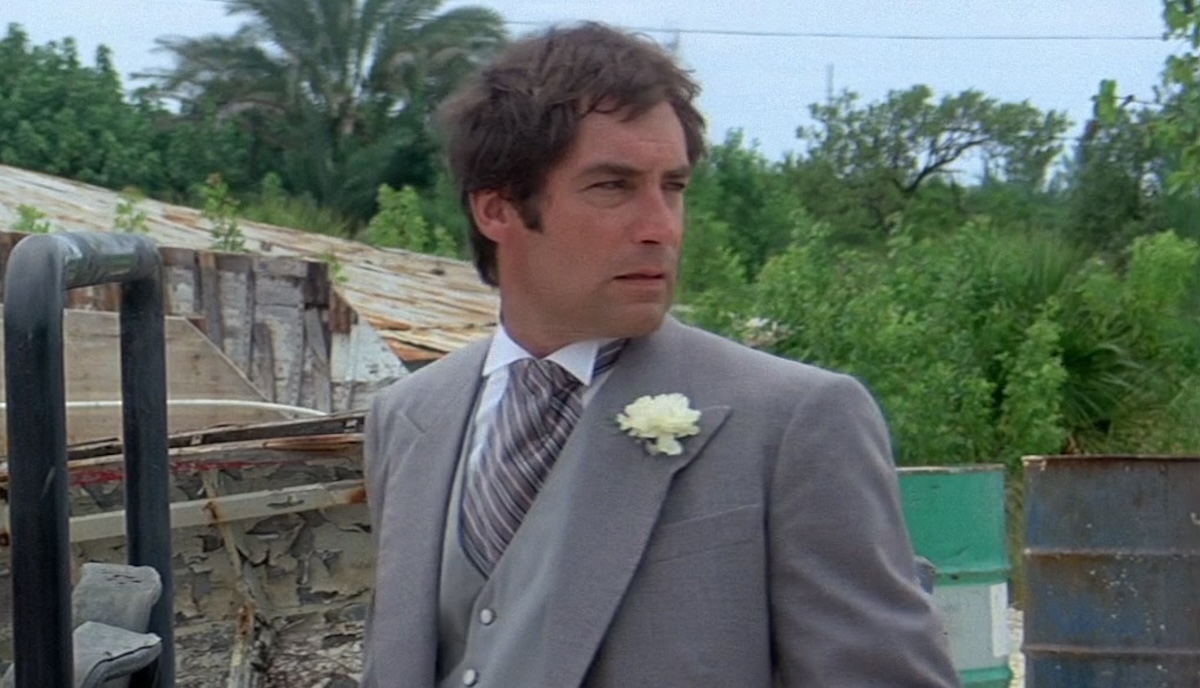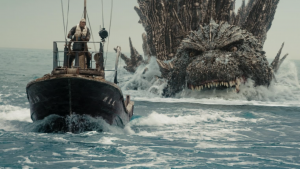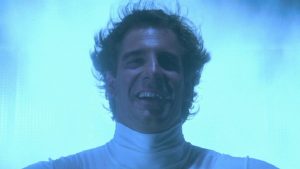
Secret agents going rogue is such a common trope that sometimes we wish that people like Ethan Hunt or Jason Bourne would just follow their orders for change. When Daniel Craig started playing James Bond in 2006, it seemed like Bond went rogue on nearly every single mission, including most of Quantum of Solace, at least half of Skyfall, and basically, the first two-thirds of No Time To Die. Pierce Brosnan’s Bond went rogue in Die Another Day, too, with a full beard and no shirt, declaring “I’m checking out” from a hospital. And of course, Connery’s Bond was on an unsanctioned revenge mission at the start of Diamonds Are Forever.
But the most compelling Bond-goes-rogue movie of them all to this day remains Licence to Kill, which in 1989, would become the unintended swan song from Timothy Dalton’s fierce take on the character.
On June 13 of that year, Licence to Kill opened at the Odeon Leicester Square in London. By July, it was in cinemas worldwide and would go on to be the first film in the franchise to pretty much flop at the box office. And yet, 35 years later, Licence to Kill is not only a solid Bond movie but a harbinger of where the action spy genre was heading all along. In other words, if this movie was made today, it might have been considered one of the best Bonds ever.
Written by franchise veterans Michael G. Wilson with Richard Maibaum and directed by John Glenn (who had helmed four previous Bond films, including The Living Daylights, Dalton’s 1987’s debut), Licence to Kill is a straight-up revenge movie that bucks against the structure and tone of every Bond film that came before it. But while moviegoers may have felt like this was an unwelcome departure, this was one of the only 007 films, prior to Daniel Craig’s tenure, that got very close to the spirit of the character from the original books.
When CIA buddy Felix Leiter (David Hedison) is fed to a shark on his wedding day, and his wife Della (Priscilla Barnes) is killed, Bond disobeys every order not to avenge his American comrade. Originally, the idea that Felix Leiter would be maimed by a crime lord comes from Ian Fleming’s 1953 novel Live and Let Die, which was the second Bond book Fleming ever wrote..Honoring that story point, Hedison, the actor who played Leiter in the movie version of Live and Let Die (1973), returned to the role of Leiter again for Licence to Kill, even though he hadn’t played the character in 16 years. Before Jeffrey Wright recurred as Leiter across three of Daniel Craig’s Bond movies, no one had played Bond’s CIA pal in more than one movie, ever.
Hedison’s appearance at the start of the film is one of the first signs that Licence to Kill isn’t really a departure at all, but actually a movie full of massive deep-cuts into both the film lore of 007, and the original Ian Fleming books too. Leiter tells his wife early in the film that Bond was married once before, a reference to On Her Majesty’s Secret Service, while the character of Milton Krest and his various illegalties are lifted from the Fleming short story, “The Hildebrand Rarity.”
In a sense, License to Kill is secretly the most bookish of the pre-21st century Bond flicks, partly because of its adherence to an Ian Fleming spirit, but also because aspects of the revenge story seem to echo both Hamlet and The Count of Monte Cristo. The film even makes a vague connection between Fleming’s brand of machismo and that of Ernest Hemingway by having M (Robert Brown) confront Bond at the Hemingway House in Key West toward the end of the first act. When M tells Bond to give up his revenge mission, Dalton delivers an almost too-perfect one-liner “I guess it’s a..ah…Farewell to Arms,” referencing the 1929 Hemingway novel, which, weirdly enough, has a plot that isn’t too different than the second half of Casino Royale.
Throughout Licence to Kill, Bond is up against a drug kingpin named Sanchez, played by one of the greatest all-time character actors ever, Robert Davi. Perhaps more famously, Sanchez is backed-up by the knife-wielding Dario, embodied by a very young, and fantastically sinister Benicio del Toro. While the pairing of Dario and Sanchez isn’t the most iconic henchman/supervillain combo ever, in 1989, it was certainly more realistic than Goldfinger and Oddjob or Jaws and whoever he happened to be working for that movie.
When Davi and del Toro are onscreen, you believe they are ruthless criminals with a massive reach. Sanchez isn’t focused on world domination, but instead just making even more money than ever off of drug smuggling. For a Bond movie, these stakes might seem slightly lower than usual, which is part of what makes the danger throughout the film actually work.
By having Leiter maimed basically right after the title sequence, the movie makes you at least a little bit worried for the various characters in the movie. Sure, you never really think Bond will die. But what about his allies and lovers? When good old Q (Desmond Llewelyn) arrives and is put on field agent duty for a change, there’s a concern there. If a stalwart ally like Leiter can be taken down a leg, is Q okay? Bond’s larger circle of companions and loved ones is strangely important in a movie that, you’d think, would be more focused on him.
In fact, for most of the movie, Bond is part of one squad or another. At the start, he helps DEA buddies Leiter and “Sharky” (Frank McRae) apprehend Sanchez. By the middle of the movie, he’s working closely with informant Pam Bouvier (Carey Lowell), Q, and Sanchez’s girlfriend Lupe (Talisa Soto). It may be a one-man mission for revenge, but it’s also a movie in which we realistically understand that Bond couldn’t do all of this stuff on his own. His actions have consequences in nearly every single scene, which, of course, is not something you can say for several Roger Moore or Sean Connery Bonds.
The film even makes it clear that Bond’s tendency to sleep around has emotional fallout. As Bouvier, Lowell’s performance allows us to believe that she’s both in love with Bond and constantly furious with him. Of all the “Bond Girls’ ‘ up to that point, Pam was significant because she specifically kicked Bond out of bed to make a point. This moment is played for a small laugh in the movie. When Bond realizes that he’s not going to be sleeping in Pam’s room, he turns toward Q, heads to the adjoining suite, and says, “I hope you don’t snore, Q.”
It’s an oddly touching moment; here’s the man who always finds himself in bed with someone, suddenly on a kind of weird family camping trip where he has to bunk with his dad. It may not make Bond seem cool, but it does make him seem real.
At the time of its release, much was made about Dalton’s fury in this film. The notion that James Bond was simply angry throughout was grating for some fans and critics who preferred the more fun-loving side of Bond. That said, for those kinds of fans, let’s not forget that just moments after Bond quits being a member of MI6, he is suddenly disguised as a manta ray, using an underwater manta ray costume he got… where? At this point in the movie Bond’s reinforcements haven’t arrived, so this seems to suggest that he either just happened to have a manta ray disguise on him (awesome) or made one himself on the fly. Either way, a Bond who is possibly knitting a bespoke manta ray disguise for himself is, on some level, at least a little bit silly.
Dalton’s angry, hardboiled take on Bond honored the Fleming source material, but more interestingly, predicted the Daniel Craig era in 2006. In Licence to Kill , Bond has very few gadgets other than a gun which only he can fire because it’s been scanned to his palm. This is exactly like Skyfall, in which Bond has a similar weapon, and also goes mostly gadgetless for a huge portion of the movie.
Licence to Kill may lack the self-awareness that the better Craig movies possess, but it’s also refreshingly straightforward when viewed today. In the end Bond doesn’t win because he’s super slick. In fact, he almost loses everything when Dario happens to recognize him from earlier in the movie. Bond’s supposed anonymity has never really made sense, and in Licence to Kill we finally realize that this guy is mostly getting by on luck and confidence.
As Sanchez says to 007, “You have cajones, Mr. Bond,” and in regard to the movie in general, he’s right. Licence to Kill had the balls not to be like films that came before it. After 1989, there was a six-year gap before the franchise rebooted again with Pierce Brosnan and GoldenEye. And so, this was the last James Bond film that felt as though it was part of the same loose continuity as the previous 15 films. It was a farewell to arms for Dalton, and a break for the franchise.
But, as always, James Bond would return, and when he did—as both Brosnan and later Craig—the lessons of Licence to Kill remained. The franchise may have lightened up a bit with Brosnan, but it never fully walked away from the harder edge and realism of Licence to Kill either. Like Dalton’s portrayal of 007, the impact of Licence to Kill was subtle, but full of power.
The post License to Kill Is the Gritty James Bond Movie That Changed the Series Forever appeared first on Den of Geek.






